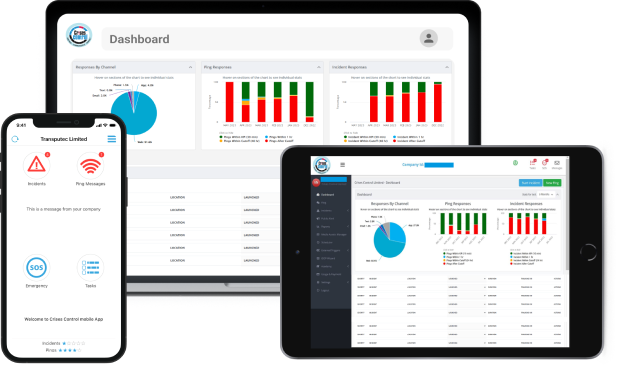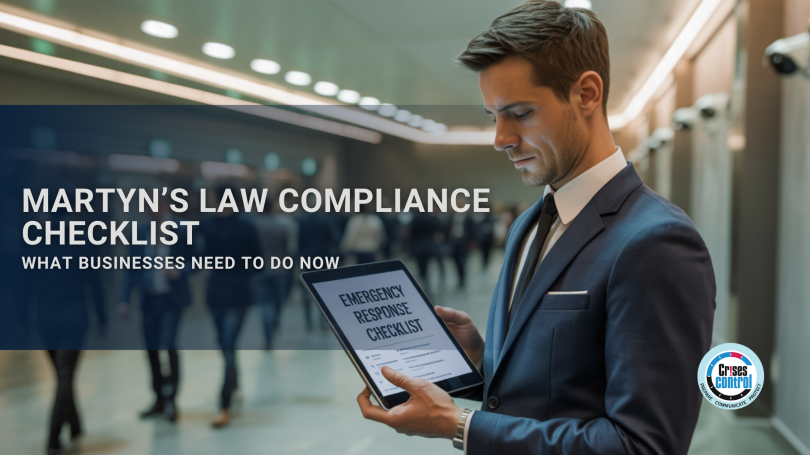Written by Anneri Fourie | Crises Control Executive
When you run a public venue or business that welcomes visitors, there’s a responsibility to keep people safe. But preparing for the threat of terrorism can feel overwhelming and complex, especially with new laws on the horizon. Martyn’s Law, also known as the Protect Duty, is set to make it a legal requirement for many organisations to have robust plans in place to reduce harm during a terrorist attack. The challenge for venue managers and business owners is understanding exactly what they must do to meet this law, and how to do it properly.
This blog lays out a practical compliance checklist to guide you through the key steps you need to take. It also explains how tools like Crises Control can make the process simpler, helping you stay on top of your responsibilities while genuinely improving safety.
Why Martyn’s Law Matters to Your Venue
Martyn’s Law is named after Martyn Hett, one of the victims of the tragic 2017 Manchester Arena bombing. In the wake of that event, the government recognised there was a serious gap in how public venues prepared for and responded to terrorist threats. The law aims to close that gap by requiring organisations to understand the risks they face, train their staff accordingly, and have clear plans to act if something goes wrong.
This isn’t just about ticking boxes. It’s about making sure that venues can protect the people who come through their doors. Whether you run a small community centre or a large stadium, the safety of visitors and staff depends on how well you plan and prepare.
Martyn’s Law breaks venues into two groups based on size and risk:
- Standard Tier: Venues with a capacity of 100 or more people. These organisations must carry out basic risk assessments, train staff, and have simple emergency plans.
- Enhanced Tier: Venues with a capacity of 800 or more people. These need more detailed risk assessments, formal security plans, systems for communication during incidents, and must regularly test their preparations.
Even if your venue falls below these thresholds, reviewing your security and emergency plans is a wise step, given the unpredictable nature of threats today.
Your Practical Martyn’s Law Compliance Checklist
Meeting Martyn’s Law means more than writing a document and filing it away. It means building a real capability to recognise risk and act quickly and effectively. Here is a clear checklist of the key actions you should take:
1. Confirm Your Venue’s Tier and Responsibilities
The first thing to do is to understand if you fall under the Standard or Enhanced Tier, based on your venue’s capacity and type. While capacity is a clear factor, also consider your venue’s layout, use, and foot traffic. If you’re unsure, preparing as if you are in the higher tier ensures you won’t fall short.
Knowing your tier will shape the depth of your risk assessments, training, and planning.
2. Carry Out a Detailed Terrorism Risk Assessment
This step requires you to think carefully about the specific threats to your venue. A terrorism risk assessment goes beyond your usual health and safety checks. Consider:
- What kinds of attacks could be most likely at your site? For example, could an attacker exploit entry points or busy areas?
- Where are your most vulnerable spots, such as large crowds, narrow corridors, or places with limited escape routes?
- What security measures do you currently have, and are they enough?
- How might someone intent on causing harm try to use your venue’s layout against you?
Having a clear, up-to-date risk assessment provides the foundation for all your emergency planning. Digital platforms like Crises Control can help you create, store, and update these assessments easily, ensuring your understanding of risks evolves with any changes.
3. Develop a Clear Emergency Response Plan
Once you understand your risks, you need a plan that tells everyone what to do if an incident happens. This plan should be straightforward, avoiding jargon or unnecessary complexity. It must clearly assign roles and responsibilities and cover:
- Procedures for evacuation or sheltering in place
- How to communicate internally and with emergency services
- Ways to keep both staff and visitors safe during an incident
Using a centralised tool to manage your plans means they’re easy to access when needed, whether on a desktop or mobile device. Crises Control provides this functionality, helping keep plans current and ready to share with the right people.
4. Train Your Staff on Terrorism Awareness and Emergency Procedures
Staff are the frontline of any emergency response. They need to understand what to look out for and how to react calmly and correctly. Training should include:
- Recognising suspicious behaviour or unattended items
- Knowing the steps to take during different emergencies
- Familiarity with your venue’s emergency plan and communication methods
Training should be repeated regularly to keep knowledge fresh and build confidence. With Crises Control, you can upload training materials and track which staff members have completed their courses, identifying any gaps early.
5. Set Up Reliable Communication Systems
When an emergency happens, seconds matter. Martyn’s Law requires venues to have communication systems that quickly reach staff and emergency services. Effective communication covers:
- Sending alerts through multiple channels such as SMS, voice calls, emails, and mobile app notifications
- Immediate notifications to security teams, management, and first responders
- Communication protocols tailored to different scenarios and staff groups
Crises Control’s platform specialises in rapid, multi-channel messaging and two-way communication, making sure your team stays connected and informed when it counts.
6. Test, Review, and Update Your Plans Regularly
An emergency plan is only as good as its testing. Regular exercises, whether table-top discussions or full-scale drills, reveal weaknesses and keep teams prepared. After each test, update your risk assessments and plans to reflect any new insights or changes to your venue, staff, or threats.
A system that logs all drills and updates supports your compliance efforts and provides an audit trail. Crises Control automates this record-keeping, so you can easily demonstrate continuous improvement.
How Crises Control Supports Your Martyn’s Law Journey
The process of complying with Martyn’s Law involves ongoing work, from assessing risks to training staff and running drills. Crises Control is designed to support every part of this journey with a single platform that keeps everything organised and accessible.
- Centralised Risk and Plan Management: Store your assessments, emergency plans, and site details in one place. Updates are quick and transparent, helping you stay current and in control.
- Training Oversight: Upload materials and track completion so you know your team is prepared.
- Instant Multi-Channel Alerts: Communicate rapidly via SMS, voice calls, emails, and app notifications to reach the right people instantly.
- Drill Management and Reporting: Plan exercises, monitor responses, and generate audit reports automatically to meet legal requirements.
- Remote Control and Access: Manage incidents and communication from desktop or mobile, no matter where you are.
By using a tool built specifically to manage crises and emergencies, you reduce complexity and improve your confidence in meeting legal obligations, and more importantly, in keeping people safe.
What You Should Do Next
Martyn’s Law compliance isn’t something to leave until the last minute. Starting early helps you:
- Understand your venue’s risks in detail
- Build clear and tested emergency plans
- Train your staff thoroughly and regularly
- Set up reliable, fast communication systems
- Practice and improve through regular drills
Following the checklist above will put you in a strong position. It reduces your risk, protects your people, and makes meeting legal requirements much more straightforward.
Book a Free Demo: See How Crises Control Can Help You
Preparing for Martyn’s Law can feel daunting, but it doesn’t have to be. Crises Control offers an easy-to-use platform that helps you manage every part of the process — from risk assessments and training to emergency alerts and drill management.
Contact us today to book a free demo and find out how Crises Control can make compliance simpler, safer, and more effective.
Request a FREE Demo

